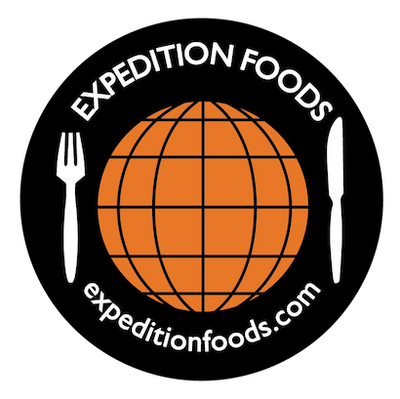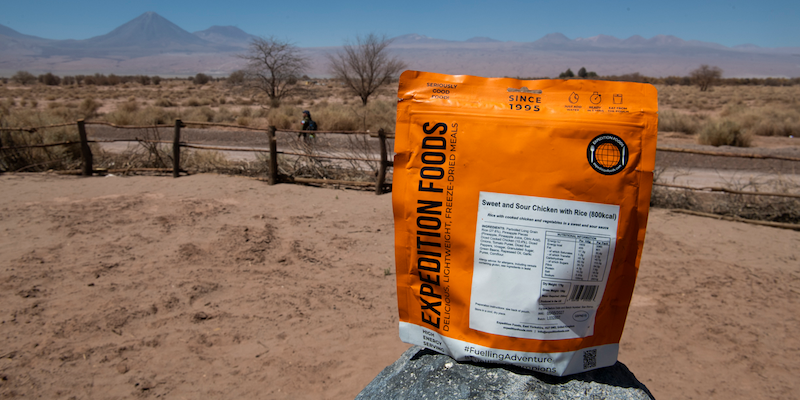-
Meals
-
Ration Packs
-
Special Diets
- Survivor Foods 25-Year Tins
-
Snacks, Drinks & Accessories
- About Us
Become a Polar Explorer with Louis Rudd & Wendy Searle
May 25, 2023

Well-known polar explorers Louis Rudd and Wendy Searle have teamed up with Shackleton on their latest venture, to start 'Shackleton Challenges'. We asked them what it's all about.
Expedition Foods (EF): What are 'Shackleton Challenges' and how did you get involved?
Louis Rudd (LR): The background was: While I was still serving in the army I did the Spirit of Endurance expedition which was the solo crossing of Antarctica in 2018 - 2019. Shackleton was one of my commercial sponsors. Co-founded by Ian Holdcroft and Martin Brooks, the company was created out of their shared passion for all things Shackleton. It was established as a clothing brand. I used some of their clothing on my Spirit of Endurance expedition. After working together they said, "When you do leave the military, come and speak to us first".
A couple of years ago, I finished in the military after 34 years, and decided it was time to do something different. I went and sat down with Shackleton and they said they'd like to set up an expedition part of the company and asked if I would like to come onboard and be director of expeditions. I really liked the idea, and thought it was a great concept. I liked that I could create Shackleton Challenges the way I thought it should be done.

EF: Wendy, have you done a lot of work with the Shackleton Challenges?
Wendy Searle (WS): This year has been quite intense. We did a pilot in 2019 just before covid, so our first couple of actual challenges were Feb 2022 in Finse, Norway. We've done challenges in Norway, the Alps and Iceland as well.
Most recently we had a lot of clients come out to Finse to work with us this past few weeks. For Finse we're out for 6 or 7 weeks. We go out and do the set up and then we have clients rolling in. It's a lot, but it's fantastic. I've done lots of expeditions with Louis, and since last year was my first season guiding, I thought that to be a good guide I needed to be exactly like him. His leadership style is like Jedi mind tricks and I realised I've just got to be myself and be authentic. It turns out there are lots of different ways to be a good guide.
We have had great teams of people every week who have become friends, lots of them have been to visit us in Wales, and some have been inspired to prepare for bigger challenges.
EF: Can you tell us more about Shackleton Challenges? How do they work?
LR: Our natural environment is polar (with my background and the Shackleton business) so we started with polar. We scale the expeditions levels 1 to 5:
Level 1
LR: This is the entry level polar skills course. It is run in Finse, Norway, which is where Captain Scott, Shackleton and Armundsen all trained, so it's got a lot of history behind it. You fly into Oslo and catch the snow train which goes up into the mountains. You get off in Finse (the highest point along the line), and stay in the same hotel where Scott, Armundsen and Shackleton all stayed. It's a nice hotel and the perfect expedition base, sitting in the heart of the Hardangervidda National Park. You can ski out of the door straight into the wilderness.
For Level 1 there is lots of teaching, then you're out every afternoon on the frozen lake practicing everything you've been taught. Getting used to expedition skis, travelling through undulating terrain, skiing with a pulk, putting the tent up, firing up the cooker. We finish up the week with an overnight expedition where we camp out at -20c then head back to the hotel for a celebratory dinner.
WS: On Level 1 we go through so much, from the layering system to keep you at the correct temperature, why expedition skis are different and how to use them, the pulk and how to pack it, the camp routines like putting your tent up in the correct orientation to the wind, the cookers - everything about polar travel has a lot of details to get right. It sounds like such a simple thing, e.g. putting the tent up or getting the cooker going but the cooker needs to be primed, you need to know how to service it when you're going out on a long expedition on your own, so it's enough for people to have a safe and fun experience without overloading them completely. But those basics you really do have to get right.
We have a lot of fun doing it. It's quite difficult to maneuver a pulk downhill when you're on skis. There are a few methods of doing that and people fall all over the place. Yes, it's serious, if things go wrong then they can go seriously wrong in that environment, but we have some fun during the training. We have 6 clients to 2 guides so there's always a guide in each tent. It's a fun, safe (as possible) environment to learn in.
Level 2
LR: We run Level 2 Shackleton Challenges in Iceland, and they include more nights out, practicing routines practically and some teaching, mainly focused on navigation. WS: Level 2 is a lot more full on and mostly teaching on the go. Ideally you'll have done Level 1, but we take people on a case-by-case basis. People might have done multi-day hikes, skiing, mountaineering, etc.

Level 3
LR: Level 3 is a 5-day expedition covering 100km, so much tougher, and is for people with experience. We keep the numbers small, and have a 3:1 ratio of clients to guide.
WS: Level 3 and beyond it's helpful for us if you've done level 1 or 2 with us. We provide all the training plans from 6 months out. We give talks once a month on different elements of preparedness for the expedition: people come on and give presentations about clothing, nutrition, etc. and you can ask questions.
By the time everyone arrives, we all know each other, clients know what to expect, they know a lot of the details already. You're not just signing up and turning up, you're actually part of something.
Level 4
LR: I recently delivered this, in Antarctica. We get dropped at 89 degrees south and ski the last degree - 110km, spending a week in Antarctica at -40 degrees celcius at 9000ft altitude; it's not to be underestimated. The whole thing is a two-week expedition including the travel.
Level 5
LR: This is the ultimate Shackleton Challenge - a full distance expedition in Antarctica. Skiing from the coastline to the South Pole. There are some traditional routes - Hercules Inlet, the Mesner start point. We do something completely different - traversing from the base of base of the Shackleton Glacier, across the high polar plateau to the Geographic South Pole.
We get dropped off at the base of the Shackleton Glacier in the Transantarctic Mountains. We will traverse approximately 120 miles up the glacier delivering us to the high polar plateau. Then it's a further 300 miles to finally arrive at the South Pole after approximately 40 days on the ice. To prepare for this ground-breaking expedition clients undergo a tailored 2-year mental and physical preparedness programme.
The Level 5 expedition will be limited to four people. The maximum loading for the plane is 6, 4 clients and 2 guides.
EF: Are people starting to come back and do the next level up?
WS: We have a lot of people come in at level 1, then a significant number coming through to do the next level. One of our clients came on a level 3 and was thinking of coming back and doing it again, but I told him he needed to aim for the next challenge up, the one that he didn't quite think he could do.

EF: What would a day's food look like on an expedition?
LR: In the morning we have a freeze-dried breakfast, such as Expedition Foods Porridge with Strawberries - that is very popular. We hydrate, as well, with things like hot chocolate, protein powder, tea, coffee, etc.
Through the day we have a grazing bag including chocolate, nuts, energy bars, cheese, salami, dried fruit. It's all personal preference, people make these themselves. The food freezes so we recommend what to have in grazing bags based on experience. Some things just don't work in the grazing bags - e.g. something sticky. It's important to fuel yourself throughout the day, and keep the energy coming in. We also carry a lot of drinks to have throughout the day.
In the evening we get back into the tents, melt snow, and have a freeze-dried main meal (usually Expedition Foods) and a pudding - the Chocolate Chip Biscuit Pudding is legendary stuff. I love that.
Generally, we drink some sort of protein powder or something to stock up the calories - between 4 and 5 thousand calories per day for a basic polar challenge; in Antarctica we aim more towards 6 thousand calories per day. In Antarctica you can burn close to 10 000 kcal in a day - fighting off the cold, hauling for 10 - 11 hours. Nutrition/rations are scaled depending on level of activity.
EF: What do people get out of doing a Shackleton Challenge?
WS: You come back with a different perspective on everything. You learn about what's important in life. It's the little things in life that other people would find to be big annoying things - like flight delays, traffic jams, etc., everyday annoyances - they become less important. You start appreciating running water, kettles, flushing loos, etc. This is stuff that we forget to be thankful for.
Being able to expand your comfort zone and be comfortable with being uncomfortable. When we go as a team the team dynamic is so special. The bonds are something else; you become friends for life.
LR: People come and ask where do I start, what kit do I use, how do I go about this. These challenges create a pathway for people. Putting all of our experience into these packages - skis, tent, boots, this is how we help people to physically and mentally prepare. Everything is provided as part of the package including a £1000 pulk jacket suitable for challenges, and of course your food, usually Expedition Foods meals.

EF: What does the future hold for Shackleton Challenges?
LR: We're looking to expand in the future to all environments - ocean, jungle, desert, you name it. We want to offer Shackleton Challenges globally.
To find out more, take a look at the Shackleton Challenges website - here.
Also in Stories

Government Recommended Emergency Kit
November 21, 2024

Karakoram Mountains of Northern Pakistan
October 25, 2024

Antarctic Fire Angels - Union Glacier to the South Pole
September 12, 2024


